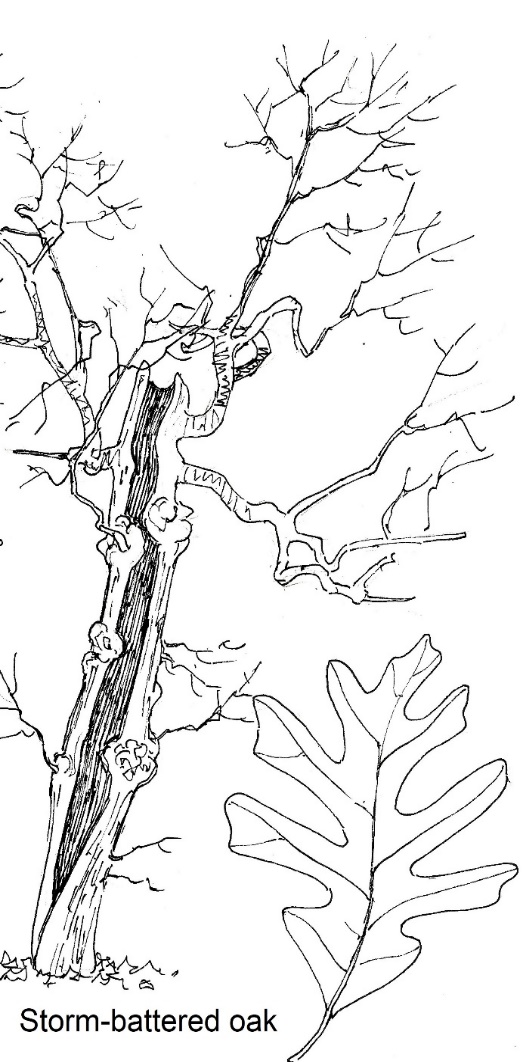The mention of virgin Arkansas forest conjures up images of massive ranks of white oak columns or soaring canopies of stately shortleaf pine, but ecologists have found virgin forest hiding in plain sight all across America. These are modest forest plots that have remained uncut and undisturbed because they inhabit rough and non-arable land covered by crooked and unmerchantable trees. A decade ago Harvard researchers made news when they documented virgin forest adjacent to the Wachusett Mountain ski area within the metropolitan Boston area. More recently, the UARK tree ring lab showed that virgin chinquapin oak and post oak stands were growing on Mt. Kessler within Fayetteville city limits. Crooked and storm-battered trees there were as much as 300 years old. That was one factor that prompted the city’s purchase of the Mt. Kessler property to preserve it for future outdoor recreation.
Ozark Society members recently had the opportunity to experience another Arkansas area of virgin forest – and one that covers a much more extensive area than the limited stand of oaks on Mt. Kessler. This was during our Society fall meeting in November at Queen Wilhelmina State Park lodge, where some of us hiked a five-mile section of trail following the crest of the Winding Stair Mountains from the Oklahoma state line to the Wilhelmina lodge parking lot. I had hiked in the area decades ago while on assignment in eastern Oklahoma and had returned more recently to hike the Ouachita Trail. The stunted oak forest that lines the highest points along the Talimena Highway grows out of fissures in exposed sandstone ledges and the trees are so crooked and battered that they would never fear the lumberman.

So, this was yet another opportunity to experience virgin Arkansas forest. I had been especially interested in the fact that most of the oaks in this pigmy forest were white oaks – the species we associate with the richest hardwood stands on the deep, well-drained soils of Ozark valleys. We think of post and blackjack oaks as the characteristic trees of exposed rock outcrops and glades. Perhaps this was just a misunderstanding on the basis of limited exposure to these ridgetop trees as I followed trails down into adjacent valleys. This time we would walk parallel to the highway on the south facing side of the ridge long enough to have a real representative sample of forest composition.
After a mile or so it was clear that this really was a white-oak-dominated forest with a little bit of black oak and hickory, and no sign of post or blackjack oak at all. The thick-husked nuts on the ground and the consistent 7-leaflet count on fallen hickory leaves showed that the tree was mockernut and not Texas hickory we see so often on dry ridges around the Buffalo River.
The low stature of the forest was produced by the consistently broken tops of the largest trees, where the upper part of the trees had been sheared off by wind or ice storm damage some 15-20 feet above the ground. That made them taller than the truly stunted trees on the highest crest of the ridge, but still dwarfed by comparison to white oak stands we are used to in the Ozarks. We encountered concentrations of cucumber magnolia in small depressions as well as basswood around rocky talus slopes as local departures from the predominantly white-oak forest composition. A vibrant note of color was added by nearly continuous thickets of fall-flowering witch hazel with a bright yellow fuzz of clustered flowers glowing in the fall sunshine. The other common understory shrub was red buckeye, sometimes attaining almost tree status in places even though it was far above its usual streamside habitat.
The size attained by these shade-loving and slow-growing shrubs attested to the long length of time over which this forest has remained undisturbed. Dense tangles of greenbrier mostly discouraged movement off trail. Coming close to the lodge there were stone walls and an old cemetery indicating that we had entered second growth forest. The main difference here was that sweetgum, a notorious responder to forest disturbance, had become part of the overhead canopy.
The biggest surprise of all was to see so much of the uncommon understory tree gum bumelia (also known as gum bully, Sideroxylon lanuginosum). The tree stood out in the deciduous forest along the Talimena highway where other trees had already dropped their leaves because gum bumelia is semi-evergreen. It looks a lot like American holly in shape and growth form, and is just as prickly to approach except that the thorns arise from the base of the leathery, oblong leaves rather than from the leaf margins. I had seen the tree growing along the crest of rock ledges at the Steel Creek overlook along the Buffalo River, but tree books usually describe it as an endemic of the Texas hill country. This added another interesting footnote to our exploration of an intriguing dwarf forest formation that differed from much of what we see elsewhere in Arkansas. And we had the opportunity to see a small part of what Arkansas was like in the years before Lewis and Clark contemporaries Dunbar and Hunter first visited the Ouachita headwaters in the early 1800’s.
